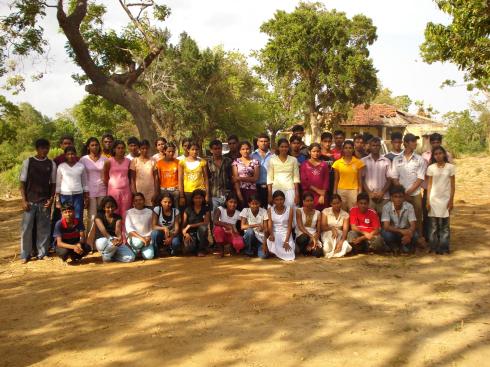A Holistic Approach to Disaster Risk Reduction
Background
Andaragasyaya Grama Niladhari Division is located in the Tissamaharama Divisional Secretariat Area in the Hambantota District. Pattiyawelayaya , Andaragaayaya and Kirindagodana are villages which constitute the Andaragasyaya GND belonging to historic Magam Pattuwa in the Dry zone of Southern Province. Andaragasyaya Grama Niladhari Division spreads over 950 acres of land. The village is frequently prone to floods and drought. The 2004 tsunami destroyed village livelihoods, infrastructure and 2 hectares of mangrove habitat in the village. The main livelihoods of the community are sea fishing, paddy farming, and chena cultivation (home gardens). 20 acres of paddy land is affected by flooding every year, due to continuing hazard the community had abandoned farming within the 20 acres. The existing canal system is 6 feet wide, and brings down spillage water from a cascade of five irrigation tanks (Tissa tank, Weeravila tank, Pattegamuwa tank, Debarawawa tank, and Yogawawa tank) through Andaragsayaya. The canal falls in to the sea from Andaragsayaya G.N. Division. When tank gates of the cascade opens after heavy rains the Andaragasyaya village get flooded.
Strategic Approach to DRR
During the Disaster preparedness workshops, and Disaster Management Planning meetings, the community had a higher emphasis on flood mitigation. The Village Coastal resources Management (CRM) plan also suggested how the majority of abandoned paddy land can be re-cultivated through managing the canal system of the village. Considering the environmental, livelihood and disaster mitigation factors and their benefits, the SRTAC project intervened in the very much neglected village infrastructure development issue.
Ground work
Several community consultation meeting had to be held with the village CBOs, and the community. The village framers were a direct beneficiary of the implementation, as well as people living in the flood prone areas. The village local government agent, Grama Niladari, became the leader of the development process. Consultation meeting were held with Irrigation department, and Disaster management centre to draft the best way forward. Finally a village Canal Development committee was formed by volunteer from the village, where the Grama Niladari was appointed as the president. The irrigation officer explained the process for the constructing the canal, and prepared the plan for the canals. The Village Canal Development Committee (VCDC) appointed a village tender board to facilitate the equipment procurement and service outsourcing process. The VCDC gave their volunteer labor clear the bushes, and thicket. The VDCD then outsourced the heavy duty earth excavation work to selected service provider.
Benefits of the Project
Primary Benefits
Flood Mitigation
The canal was excavated 30 feet wide and 1700 meter long, and the canal mouth was widened. During the recent flooding in November 2008, the flood water seized rapidly with in a day. Normally the flood water would have stagnated for 3- 4 days continuously.
Restoring Paddy Cultivation
Farmers who had abandoned 20 acres of Paddy land had started cultivating in the new season. The SRTAC project has introduced organically grown saline resistant traditional paddy farming to the community as disaster resistant livelihood. This was the first time the community was exposed to the benefits of traditional paddy.
Mangrove Restoration and habitat conservation
Adjacent to the main canal, we have tried to demonstrate novel approach to mangrove planting. The project has tried replicating the MSSRF’s concept of canal based mangrove planting. Over *****hectares of land have been planted mangroves. Planting locally growing species of mangroves was an initiative to restore the tsunami destroyed 2 hectare of mangrove habitat. The mangrove thickets at andragasyaya are habitat for crustaceans, fish, birds and crocodiles.
The sustainability and Maintenance of the Canal
In order to ensure future maintenance of the canal a canal maintenance fund will be created in a fix deposit under the Authority of Divisional Secretariat of Kirinda. When requirement for de-silting the canal arise, the community can maintain the canal using the interest earned from the fix deposit. Funds will only be released under the recommendation of Irrigation department, DMC. The decision at the village level is made by G.N. of the village, and the Village Disaster Management Committee for canal maintenance. Finally when work is completed the G.N. and the Sarvodaya district coordinator will certify the actual expenditure for the Divisional Secretariat of Kirinda to give permission to release funds.
Such community based, and de-centralized approaches DRR has created much enthusiasm about DRR with in the community. The whole exercise has improved community volunteerism creating harmony among village CBOs. As a secondary benefit the activity has establishing better links with government department (DMC. CCD, Irrigation Dep.). As result of the canal construction process the community was empowered request form the Road Development Authority to mend the long neglected broken bridge in the village.








 "Building inner spiritual resilience is the primary coping mechanism to external disasters "
Dr A T Ariyaratne, Founder President, Sarvodaya
"Building inner spiritual resilience is the primary coping mechanism to external disasters "
Dr A T Ariyaratne, Founder President, Sarvodaya
 "Is small still beautiful? We think it is. In an increasingly divided and fragile world, Practical Action aims to demonstrate and advocate the sustainable use of technology to reduce poverty in developing countries" -PRACTICAL ACTION
"Is small still beautiful? We think it is. In an increasingly divided and fragile world, Practical Action aims to demonstrate and advocate the sustainable use of technology to reduce poverty in developing countries" -PRACTICAL ACTION



